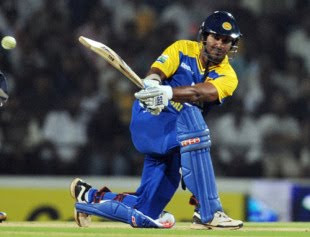 Sri Lanka 215 for 5 (Sangakkara 78*, Kapugedera 47) beat India 186 for 9 (Gambhir 55) by 29
Sri Lanka 215 for 5 (Sangakkara 78*, Kapugedera 47) beat India 186 for 9 (Gambhir 55) by 29Kumar Sangakkara equalled the record for the fastest fifty by a Sri Lankan
Kumar Sangakkara starred with his highest Twenty20 score, a serenely-destructive 37-ball 78, as Sri Lanka thumped India by 29 runs in Nagpur. Chamara Kapugedera pitched in with a cameo to charge Sri Lanka to 215, a total that proved too much for India, who fell away after a promising start provided by Gautam Gambhir.
Gambhir tried valiantly with a counter-attacking fifty but it was Sangakkara who stole the show. He played only one dot ball till reached his fifty - from 21 deliveries, the quickest for Sri Lanka - but it wasn't a conventional Twenty20 knock in which the batsman goes hell for leather. There weren't many ugly swipes or heaves and anything unconventional was designed with the field in mind.
Sangakkara's innings sparked off in the ninth over against Pragyan Ojha's left-arm spin.
He chipped the first delivery he faced from Ojha over mid-on, swept the next to the boundary and lifted the third for a six over long-on. There were more classy strikes, the highlight being a chipped shot over mid-on to a length delivery from the debutant Ashok Dinda. Sangakkara's predetermined shots also came off perfectly: when he shuffled to the off side, the ball was invariably so full that it was easily lapped around the corner; when he moved outside leg, he flat-batted short-of-length deliveries over mid-on or mid-off.
It wasn't a solo show from him, though. Sangakkara found support from his partners at various points in the innings - Tillakaratne Dilshan at the start, unfurling a couple of on-the-up hits, Chamara Kapugedera in the middle and Angelo Mathews at the very end. Kapugedera was fluent against everyone but he reserved his best for Ashish Nehra, looting 18 runs from the 19th over with four boundaries to all parts of the ground - a punch over cover, a pull, a slice and a cut over point - which reflected the bowler's poor lines.
The run-glut came after India started with four tight overs, only for their bowling and fielding to disintegrate under pressure. Nehra and Ishant Sharma got the ball to skid from short of a length and cramped the openers for room but the fielding gave way first after which the bowling buckled under the assault. Yuvraj Singh dropped a sitter at point off Jayasuriya when he was on 2.
After the let-off, Jayasuriya went berserk in the fifth over, bowled by Nehra, taking him for 22 runs with five boundaries, including two lap-shots past the short fine-leg fielder. Dilshan was dropped too, with Ishant missing a straightforward return chance, and he too took full toll. Though the openers didn't go on to make big scores, they had broken the shackles and set the platform for Sangakkara to play a gem.
Despite Virender Sehwag's fall in the third over, Gambhir helped India take 76 from the Powerplay but their hopes started to sink with his departure. Gambhir's was a cheeky yet intelligent innings and he peppered the off-side field with his well-timed drives - the highlight being a sequence of seven fours from nine deliveries spread over two overs from Lasith Malinga and Nuwan Kulasekara. Despite a crowded field - a short point, backward point, cover point and cover were in place - he stole five of those seven boundaries through the off side. However, he fell while trying to paddle sweep Angelo Mathews and India lost four more wickets, including those of MS Dhoni and Yuvraj Singh, in three overs as the chase derailed spectacularly. The bowling was disciplined, without ever being threatening, but India were done in by the pressure of the steep run-rate
